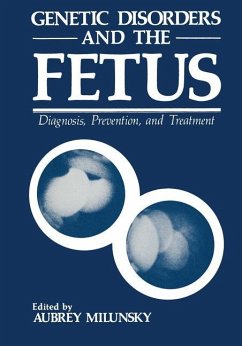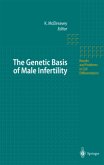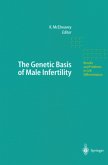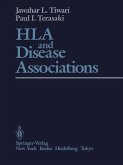Genetic Disorders and the Fetus
Diagnosis, Prevention, and Treatment
Herausgegeben:Milunsky, Aubrey
Genetic Disorders and the Fetus
Diagnosis, Prevention, and Treatment
Herausgegeben:Milunsky, Aubrey
- Broschiertes Buch
- Merkliste
- Auf die Merkliste
- Bewerten Bewerten
- Teilen
- Produkt teilen
- Produkterinnerung
- Produkterinnerung
Technological advances continue to expand the number of genetic disorders that can be diagnosed in utero. Utilization of this new technology has de manded special expertise available in relatively few academic centers. As these new applications have become more widespread so have the realities of the medicolegal implications. Notwithstanding the laboratory challenges, most legal action, at least in the United States, has arisen from the physician's failure to inform a patient about the risks of a genetic disorder or the oppor tunities presented by prenatal diagnosis. Hence an extensive…mehr
Andere Kunden interessierten sich auch für
![Genetics and the Law III Genetics and the Law III]() Genetics and the Law III41,99 €
Genetics and the Law III41,99 €![Genetic Mosaics and Chimeras in Mammals Genetic Mosaics and Chimeras in Mammals]() Genetic Mosaics and Chimeras in Mammals81,99 €
Genetic Mosaics and Chimeras in Mammals81,99 €![Genetic Counseling Genetic Counseling]() Walter FuhrmannGenetic Counseling41,99 €
Walter FuhrmannGenetic Counseling41,99 €![New Approaches in Eukaryotic DNA Replication New Approaches in Eukaryotic DNA Replication]() New Approaches in Eukaryotic DNA Replication41,99 €
New Approaches in Eukaryotic DNA Replication41,99 €![The Genetic Basis of Male Infertility The Genetic Basis of Male Infertility]() Ken McElreavey (ed.)The Genetic Basis of Male Infertility161,99 €
Ken McElreavey (ed.)The Genetic Basis of Male Infertility161,99 €![The Genetic Basis of Male Infertility The Genetic Basis of Male Infertility]() The Genetic Basis of Male Infertility149,99 €
The Genetic Basis of Male Infertility149,99 €![HLA and Disease Associations HLA and Disease Associations]() J. L. TiwariHLA and Disease Associations82,99 €
J. L. TiwariHLA and Disease Associations82,99 €-
-
-
Technological advances continue to expand the number of genetic disorders that can be diagnosed in utero. Utilization of this new technology has de manded special expertise available in relatively few academic centers. As these new applications have become more widespread so have the realities of the medicolegal implications. Notwithstanding the laboratory challenges, most legal action, at least in the United States, has arisen from the physician's failure to inform a patient about the risks of a genetic disorder or the oppor tunities presented by prenatal diagnosis. Hence an extensive thorough reex amination of the subject seems appropriate and timely. The steady escalation in the number of prenatal genetic studies now being done in the western world makes it imperative for the physician to have a thorough comprehension of the subject in its entirety. I am, therefore, fortu nate in having colleagues who as acknowledged experts have shared their knowledge and experience in order to make this volume a major critical repository of facts and guidance about prenatal genetic diagnosis. The subject matter ranges from a consideration of required genetic counseling through the intricacies of establishing prenatal diagnoses. Special attention is focused on new advances using ultrasound, a-fetoprotein, fetoscopy, and first trimester diagnosis. Both ethical and legal implications are discussed in detail, as is the development of public policy.
Hinweis: Dieser Artikel kann nur an eine deutsche Lieferadresse ausgeliefert werden.
Hinweis: Dieser Artikel kann nur an eine deutsche Lieferadresse ausgeliefert werden.
Produktdetails
- Produktdetails
- Verlag: Springer / Springer US / Springer, Berlin
- Artikelnr. des Verlages: 978-1-4684-3440-8
- Softcover reprint of the original 1st ed. 1979
- Seitenzahl: 732
- Erscheinungstermin: 18. März 2012
- Englisch
- Abmessung: 244mm x 170mm x 40mm
- Gewicht: 1239g
- ISBN-13: 9781468434408
- ISBN-10: 1468434403
- Artikelnr.: 39617194
- Herstellerkennzeichnung Die Herstellerinformationen sind derzeit nicht verfügbar.
- Verlag: Springer / Springer US / Springer, Berlin
- Artikelnr. des Verlages: 978-1-4684-3440-8
- Softcover reprint of the original 1st ed. 1979
- Seitenzahl: 732
- Erscheinungstermin: 18. März 2012
- Englisch
- Abmessung: 244mm x 170mm x 40mm
- Gewicht: 1239g
- ISBN-13: 9781468434408
- ISBN-10: 1468434403
- Artikelnr.: 39617194
- Herstellerkennzeichnung Die Herstellerinformationen sind derzeit nicht verfügbar.
1 Genetic Counseling: Prelude to Prenatal Diagnosis.- 1. Introduction.- 2. Guiding Principles in Genetic Counseling.- 2.1. Accurate Diagnosis.- 2.2. Nondirective Counseling.- 2.3. Concern for the Individual.- 2.4. Truth in Counseling.- 2.5. Confidentiality and Trust.- 2.6. Timing of Genetic Counseling.- 2.7. Parental Counseling.- 3. Prerequisites for Genetic Counseling.- 3.1. Knowledge of the Disease.- 3.2. Physician as Counselor.- 3.3. Ability to Communicate.- 3.4. Knowledge of Ancillary Needs.- 3.5. Humanity.- 3.6. Efficacy of Genetic Counseling.- 4. Principles in Practice: Considerations Prior to Amniocentesis and Prenatal Genetic Studies.- 5. Addendum.- 6. References.- 2 Amniocentesis.- 1. Introduction.- 2. Counseling and Consent.- 3. Ultrasound Prior to Amniocentesis.- 4. Amniocentesis Technique.- 5. Timing.- 6. Amniotic Fluid Volume Required.- 7. Risks of Second Trimester Amniocentesis.- 7.1. Fetal Risks.- 7.2. Maternal Risks.- 8. The Newborn Infant and the Child at 1 Year of Age following Amniocentesis.- 9. Addendum.- 10. References.- 3 Amniotic Fluid.- 1. Introduction.- 2. Amniotic Fluid Dynamics.- 2.1. Formation and Circulation.- 2.2. Volume.- 2.3. Origin.- 3. Biochemical and Other Characteristics of Amniotic Fluid.- 3.1. Proteins.- 3.2. Lipids.- 3.3. Enzymes.- 3.4. Disaccharidases.- 3.5. Amino Acids.- 4. Miscellaneous Biochemical Constituents and Other Characteristics of Amniotic Fluid.- 4.1. Creatinine.- 4.2. Blood Group Substances.- 4.3. Antibacterial Activity of Amniotic Fluid.- 5. Addendum.- 6. References.- 4 Amniotic Fluid Cell Culture.- 1. Cell Types.- 2. Cell Viability.- 3. Culture Techniques.- 3.1. Culture Media.- 3.2. Stimulating Cell Growth.- 4. Culture Results.- 5. Problems and Pitfalls.- 5.1. Bloody Samples.- 5.2. Mycoplasma Contamination.- 5.3. Syringe Toxicity.- 5.4. Bacterial or Fungal Contamination.- 5.5. Transport and Storage of Amniotic Fluid Cells.- 6. Karyotyping of Amniotic Fluid Cells without Culturing.- 7. Some Notes on the Establishment of a Prenatal Diagnostic Laboratory.- 8. References.- 5 Prenatal Diagnosis of Chromosomal Disorders.- 1. Introduction.- 2. Frequency of Chromosomal Disorders.- 3. Frequency of Chromosomal Disorders in Fetuses and Live Births.- 4. Worldwide Survey of Prenatal Diagnosis Experience.- 5. Indications for Prenatal Diagnosis of Chromosomal Disorders.- 5.1. Maternal Age.- 5.2. Translocation Carriers.- 5.3. Previous Child with Down Syndrome (Trisomy 21).- 5.4. Advanced Paternal Age.- 5.5. Miscellaneous Indications.- 6. Problems and Pitfalls.- 6.1. Mycoplasma Contamination.- 6.2. Chromosomal Mosaicism.- 6.3. Twins.- 6.4. Polyploidy.- 6.5. Maternal Cell Admixture.- 6.6. Unexpected Abnormal Fetal Karyotype.- 6.7. Chromosomal Polymorphisms.- 6.8. Noncytogenetic Indications for Prenatal Studies.- 6.9. "Unnecessary" Prenatal Studies: Drugs, Chemicals, and Irradiation.- 7. Errors in Prenatal Diagnosis.- 8. Automated Chromosomal Analysis.- 9. Addendum.- 10. References.- 6 Sex Chromosome and X-Linked Disorders.- 1. Introduction.- 2. Prenatal Diagnosis of Sex Chromosome Disorders.- 2.1. Sex Chromosome Disorders in Phenotypic Males.- 2.2. Sex Chromosome Disorders in Phenotypic Females.- 3. Translocations Involving Sex Chromosomes and Autosomes.- 4. Prenatal Diagnosis of X-Linked Disorders.- 5. Fetal Sex Determination.- 5.1. Sex Chromatin Mass (Barr Body).- 5.2. Y-Chromosome Flourescence.- 5.3. Complete Chromosomal Analysis.- 5.4. Amniotic Fluid Testosterone.- 6. Preconception Sex Selection.- 7. Prenatal Diagnosis of Specific X-Linked Disorders.- 7.1. Lesch-Nyhan Syndrome.- 7.2. FabryDisease.- 7.3. Hunter Syndrome.- 7.4. Glucose-6-phosphate Dehydrogenase Deficiency.- 7.5. Menkes Kinky Hair Disease.- 7.6. X-Linked Ichthyosis.- 8. X-Linked Disorders Potentially Diagnosable in Utero.- 8.1. Adrenoleukodystrophy.- 8.2. The Androgen Resistance Syndromes.- 8.3. Chronic Granulomatous Disease.- 8.4. Combined Immunodeficiency Disease.- 8.5. Duchenne Muscular Dystrophy.- 9. Coagulation Disorders.- 10. Miscellaneous X-Linked Disorders.- 11. Addendum.- 12. References.- 7 Prenatal Diagnosis of Hereditary Biochemical Disorders of Metabolism.- 1. Introduction.- 2. Disorders of Lipid Metabolism.- 2.1. Tay-Sachs Disease (GM2 Gangliosidosis Type I).- 2.2. Sandhoff Disease (GM2 Gangliosidosis Type II).- 2.3. Juvenile GM2 Gangliosidosis (GM2 Gangliosidosis Type III).- 2.4. Juvenile Sandhoff Disease (GM2 Gangliosidosis Type IV).- 2.5. Adult (Chronic) GM2 Gangliosidosis (GM2 Gangliosidosis Type V).- 2.6. Generalized Gangliosidosis (Infantile GM1 Gangliosidosis Type I).- 2.7. Juvenile GM1 Gangliosidosis (Type II).- 2.8. Adult GM1 Gangliosidosis (Type III).- 2.9. Other Disorders with ?-Galactosidase Deficiency.- 2.10. Farber Disease (Ceramidase Deficiency).- 2.11. Gaucher Disease.- 2.12. Globoid Cell Leukodystrophy (Krabbe Disease).- 2.13. Fabry Disease (?-Galactosidase Deficiency).- 2.14. Familial Hyperlipoproteinemias.- 2.15. Familial Hypercholesterolemia.- 2.16. Metachromatic Leukodystrophy (Sulfatide Lipidosis).- 2.17. Multiple Sulfatase Deficiency (Mucosulfatidosis).- 2.18. Niemann-Pick Disease.- 2.19. Phytanic Acid Storage Disease (Refsum Syndrome).- 2.20. Wolman Disease and Cholesteryl Ester Storage Disease (Acid Cholesteryl Ester Hydrolase Deficiency).- 2.21. GM3 Sphingolipidystrophy.- 3. Disorders of Mucopolysaccharide Metabolism.- 3.1. Hurler Syndrome(?-L-Iduronidase Deficiency: Mucopolysaccharidosis IH).- 3.2. Scheie Syndrome (?-L-Iduronidase Deficiency: Mucopolysaccharidosis IS).- 3.3. Hurler-Scheie Compound Disease (?-L-Iduronidase Deficiency: Mucopolysaccharidosis IH/S).- 3.4. Hunter Syndrome (Iduronate Sulfatase Deficiency: Mucopolysaccharidosis II).- 3.5. Sanfilippo Syndrome (Mucopolysaccharidosis III).- 3.6. Morquio Syndrome (Mucopolysaccharidosis IV).- 3.7. Maroteaux-Lamy Syndrome (Mucopolysaccharidosis VI).- 3.8. ?-Glucuronidase Deficiency (Mucopolysaccharidosis VII).- 3.9. Glucosamine-6-sulfate Sulfatase Deficiency (Mucopolysaccharidosis VIII).- 4. Disorders of Carbohydrate Metabolism.- 4.1. Glycogen Storage Diseases.- 4.2. Galactosemia.- 4.3. Galactokinase Deficiency.- 4.4. Uridine Diphosphate Galactose-4-epimerase Deficiency.- 4.5. Mannosidosis.- 4.6. Fucosidosis.- 4.7. Mucolipidoses.- 4.8. Hereditary Hemolytic Anemias.- 5. Amino Acid and Related Disorders of Metabolism.- 5.1. Urea Cycle Disorders.- 5.2. Hyperlysinemia.- 5.3. Disorders of Branched-Chain Amino Acid Metabolism.- 5.4. ?-Methylcrotonic Aciduria.- 5.5. Disorders of Propionate, Methylmalonate, and Cobalamin Metabolism.- 5.6. Disorders of Sulfa Amino Acid Metabolism.- 5.7. Renal Amino Acid Transport Disorders.- 6. Miscellaneous Biochemical Genetic Disorders of Metabolism.- 6.1. Acatalasemia.- 6.2. Chediak-Higashi Syndrome.- 6.3. Combined Immunodeficiency Disease.- 6.4. Congenital Adrenal Hyperplasia.- 6.5. Cystic Fibrosis.- 6.6. Disorders of Collagen Metabolism.- 6.7. Cystinosis.- 6.8. Disorders of Glutathione Synthesis.- 6.9. Disorders of Proline and Hydroxyproline Metabolism.- 6.10. Disorders of Folate Metabolism.- 6.11. Huntington's Chorea.- 6.12. Hypophosphatasia.- 6.13. Lysosomal Acid Phosphatase Deficiency.- 6.14. MyotonicMuscular Dystrophy.- 6.15. Orotic Aciduria.- 6.16. The Porphyrias.- 6.17. Xeroderma Pigmentosum.- 6.18. Other Miscellaneous Disorders.- 7. Addendum.- 8. References.- 8 Biochemical and Biological Problems and Pitfalls of Cell Culture for Prenatal Diagnosis.- 1. Introduction.- 2. Biological Problems in Amniotic Fluid Cell Culture.- 3. Biochemical Pitfalls in the Use of Cultivated Aminiotic Fluid Cells for the Diagnosis of Inborn Errors of Metabolism.- 4. References.- 9 Prenatal Diagnosis of Neural Tube Defects.- 1. Introduction.- 2. Etiology.- 3. Biology of ?-Fetoprotein.- 4. Amniotic Fluid ?-Fetoprotein.- 4.1. Published Experience.- 4.2. Boston Experience.- 4.3. Twins.- 4.4. False-Positive and -Negative Results.- 4.5. Elevated AFP Concentrations in the Absence of Neural Tube Defects.- 5. Problems and Pitfalls.- 5.1. Ultrasound Prior to Amniocentesis.- 5.2. Fetal Blood Contamination of Amniotic Fluid.- 5.3. Assay Sensitivity.- 5.4. Aspiration of Urine.- 5.5. Routine AFP Assays.- 6. Other Techniques to Detect Neural Tube Defects.- 6.1. Amniotic Fluid Macrophages.- 6.2. Brain-Specific Protein.- 6.3. High-Molecular-Weight Proteins.- 6.4. ?-Trace Protein.- 6.5. Fibrinogen Degradation Products.- 6.6. Glucose.- 6.7. Proteins.- 6.8. 5-Hydroxyindoleacetic Acid (5-HIAA).- 6.9. Amino Acids.- 7. Maternal Serum ?-Fetoprotein Screening.- 7.1. Maternal Serum AFP Screening Studies.- 7.2. Miscellaneous Causes of Elevated Maternal Serum AFP Concentrations.- 8. Policy Considerations for Maternal Serum AFP Screening.- 9. Costs and Benefits.- 10. Patient and Family Considerations.- 11. Addendum.- 12. References.- 10 Diagnosis of Fetal Abnormalities by Ultrasound.- 1. Introduction.- 2. Ultrasound Imaging Techniques.- 2.1. Static B Scanning.- 2.2. Real-Time Scanning.- 3. Use of Ultrasoundin Prenatal Diagnosis.- 3.1. Enhancement of the Safety and Effectiveness of Amniocentesis.- 3.2. Diagnosis of Multiple Pregnancy.- 3.3. Accurate Assessment of Fetal Age.- 3.4. Detection of Abnormal Fetal Growth.- 3.5. Detection of Changes in Amniotic Fluid Volume.- 3.6. Direct Diagnosis of Structural Fetal Abnormalities.- 4. Comparison with Amniotic Fluid AFP.- 5. Other Major Structural Defects.- 6. References.- 7. Additional References.- 11 Radiographic Fetal Diagnosis.- 1. Introduction.- 2. Abnormalities of the Head and Spine.- 3. Other Skeletal Abnormalities.- 4. Abnormalities of Other Organ Systems.- 5. Conclusions.- 6. Addendum.- 7. References.- 12 Fetoscopy and Fetal Blood Sampling.- 1. Introduction.- 2. Background.- 3. Technique of Fetoscopy.- 3.1. General Method.- 3.2. Fetal Skin Biopsy by Fetoscopy.- 3.3. Blood Sampling by Fetoscopy.- 3.4. Risks of Fetoscopy.- 4. Technique of Placental Aspiration.- 4.1. Blood Sampling.- 4.2. Risks of Placental Aspiration.- 5. Diagnosis by Fetoscopy.- 5.1. Fetal Anatomy in Preabortion Pregnancies.- 5.2. Anatomical Diagnoses in Continuing Pregnancies.- 5.3. Potential for Visual Diagnosis with Fetoscopy.- 6. Diagnosis by Biopsy.- 7. Diagnosis from Electrical Activity.- 8. Diagnosis by Fetal Blood Sampling.- 8.1. Hemoglobinopathies.- 8.2. Muscular Dystrophies.- 8.3. Hemophilias.- 8.4. Chronic Granulomatous Diseases.- 8.5. Potential for Diagnosis Using Fetal Blood.- 9. Therapy.- 10. References.- 13 Utilization of Trophoblast for Early Prenatal Diagnosis.- 1. Introduction.- 2. The Trophoblast in Vivo.- 3. The Trophoblast in Vitro.- 4. Alternatives to Amniocentesis.- 4.1. Deported Trophoblast.- 4.2. Transabdominal Intraplacental Needle Biopsy.- 4.3. Transcervical Hysteroscopic Vacuum Biopsy.- 4.4. Transcervical Blind Vacuum Biopsy.-4.5. Sex Detection by Y-Body Analysis.- 4.6. Obtaining Trophoblast for Tissue Culture.- 4.7. Phase Contrast Analysis of Cells in the Endocervical Samples.- 4.8. Isolation of ACE Tissue from Abortus Specimens.- 5. References.- 14 Fetal Cells in the Maternal Circulation: Prenatal Diagnosis by Cell Sorting Using a Fluorescence-Activated Cell Sorter (FACS).- 1. Introduction.- 2. Fetal Cells in the Maternal Circulation.- 2.1. Frequency and Kinetics.- 2.2. Characteristics of Fetal Cells in the Maternal Blood.- 3. Prenatal Diagnosis by Cell Sorting.- 4. Addendum.- 5. References.- 15 Diagnosis, Treatment, and Prevention of Isoimmune Hemolytic Disease of the Fetus.- 1. Introduction.- 2. Counseling the Sensitized Patient.- 3. Management.- 4. Prevention.- 5. References.- 16 Role of Infectious Agents in Birth Defects: An Overview of Still-Unresolved Problems.- 1. Introduction.- 2. Agents Associated with Infection of the Fetus and Newborn.- 3. Problems in Antenatal Diagnosis and Management.- 3.1. Diagnosis.- 3.2. Prevention and Therapy.- 4. References.- 17 Elective Abortion: Techniques, Risks, and Complications.- 1. Introduction.- 2. Timing of Abortions.- 3. Techniques.- 3.1. Surgical Evacuation.- 3.2. Induction of Uterine Contractions.- 3.3. Cervical Dilatation.- 4. Conclusions.- 5. Addendum I.- 6. Addendum II.- 7. References.- 8. Additional References.- 18 Medicolegal Aspects of Prenatal Diagnosis.- 1. Introduction.- 2. Developments in the Law.- 2.1. The Right to Obtain an Abortion.- 2.2. Informed Consent.- 2.3. The Fetus and the Law.- 3. Liability of Physicians for the Birth of Children.- 3.1. The Tort of Wrongful Birth.- 3.2. The Tort of Wrongful Life.- 3.3. Implications for Prenatal Diagnosis.- 4. Addendum.- 4.1. The Tort of Wrongful Birth.- 4.2. The Tort of Wrongful Life.- 5.References.- 19 The Morality and Ethics of Prenatal Diagnosis.- 1. Moral Problems and Ethical Issues.- 2. Moral Problems in Prenatal Diagnosis.- 2.1. Risks of Amniocentesis.- 2.2. Selective Abortion.- 2.3. Indications for Prenatal Diagnosis.- 2.4. Special Problems in Selective Abortion.- 2.5. Prenatal Diagnosis, Selective Abortion, and the Defective Neonate.- 3. Ethical Issues of Prenatal Diagnosis.- 3.1. The Abortion Issue.- 3.2. The Future of Prenatal Diagnosis and Genetic Therapies.- 4. Addendum.- 5. References.- 6. Additional References.- 20 Prenatal Diagnosis and Public Policy.- 1. Introduction and Summary.- 2. Analytic Perspectives.- 2.1. The Role of Analysis.- 2.2. Risks.- 2.3. The Government-Constraints, Costs, and Benefits.- 2.4. Public Funds.- 2.5. Earnings.- 2.6. Personal Gains.- 2.7. The Gene Pool.- 2.8. The Results of Analysis.- 2.9. The Issue of Abortion.- 3. The Value of Prenatal Diagnosis.- 3.1. The Information Value.- 3.2. Mathematical Formulation.- 3.3. Interpreting the Formulation of Value.- 3.4. Setting Cutoff Points.- 4. The Context of Prenatal Diagnosis.- 4.1. The Structure of Tests.- 4.2. Evaluation.- 4.3. The General Solution.- 4.4. Action.- 4.5. Anxiety.- 5. Governmental Support for Prenatal Screening.- 5.1. Overview.- 5.2. Voluntarism and its Consequences.- 5.3. Differentiation by Means and Risk.- 5.4. Ethnic Dimensions to Risk.- 5.5. Sex Determination.- 6. Institutions and the Implementation of Policy.- 6.1. Money.- 6.2. Knowledge.- 6.3. Support.- 6.4. Ancillary Activities.- 7. Conclusion.- 8. Appendix: Carrier Screening Compared with Universal Amniocentesis for Autosomal Recessive Disease.- 9. References.
1 Genetic Counseling: Prelude to Prenatal Diagnosis.- 1. Introduction.- 2. Guiding Principles in Genetic Counseling.- 2.1. Accurate Diagnosis.- 2.2. Nondirective Counseling.- 2.3. Concern for the Individual.- 2.4. Truth in Counseling.- 2.5. Confidentiality and Trust.- 2.6. Timing of Genetic Counseling.- 2.7. Parental Counseling.- 3. Prerequisites for Genetic Counseling.- 3.1. Knowledge of the Disease.- 3.2. Physician as Counselor.- 3.3. Ability to Communicate.- 3.4. Knowledge of Ancillary Needs.- 3.5. Humanity.- 3.6. Efficacy of Genetic Counseling.- 4. Principles in Practice: Considerations Prior to Amniocentesis and Prenatal Genetic Studies.- 5. Addendum.- 6. References.- 2 Amniocentesis.- 1. Introduction.- 2. Counseling and Consent.- 3. Ultrasound Prior to Amniocentesis.- 4. Amniocentesis Technique.- 5. Timing.- 6. Amniotic Fluid Volume Required.- 7. Risks of Second Trimester Amniocentesis.- 7.1. Fetal Risks.- 7.2. Maternal Risks.- 8. The Newborn Infant and the Child at 1 Year of Age following Amniocentesis.- 9. Addendum.- 10. References.- 3 Amniotic Fluid.- 1. Introduction.- 2. Amniotic Fluid Dynamics.- 2.1. Formation and Circulation.- 2.2. Volume.- 2.3. Origin.- 3. Biochemical and Other Characteristics of Amniotic Fluid.- 3.1. Proteins.- 3.2. Lipids.- 3.3. Enzymes.- 3.4. Disaccharidases.- 3.5. Amino Acids.- 4. Miscellaneous Biochemical Constituents and Other Characteristics of Amniotic Fluid.- 4.1. Creatinine.- 4.2. Blood Group Substances.- 4.3. Antibacterial Activity of Amniotic Fluid.- 5. Addendum.- 6. References.- 4 Amniotic Fluid Cell Culture.- 1. Cell Types.- 2. Cell Viability.- 3. Culture Techniques.- 3.1. Culture Media.- 3.2. Stimulating Cell Growth.- 4. Culture Results.- 5. Problems and Pitfalls.- 5.1. Bloody Samples.- 5.2. Mycoplasma Contamination.- 5.3. Syringe Toxicity.- 5.4. Bacterial or Fungal Contamination.- 5.5. Transport and Storage of Amniotic Fluid Cells.- 6. Karyotyping of Amniotic Fluid Cells without Culturing.- 7. Some Notes on the Establishment of a Prenatal Diagnostic Laboratory.- 8. References.- 5 Prenatal Diagnosis of Chromosomal Disorders.- 1. Introduction.- 2. Frequency of Chromosomal Disorders.- 3. Frequency of Chromosomal Disorders in Fetuses and Live Births.- 4. Worldwide Survey of Prenatal Diagnosis Experience.- 5. Indications for Prenatal Diagnosis of Chromosomal Disorders.- 5.1. Maternal Age.- 5.2. Translocation Carriers.- 5.3. Previous Child with Down Syndrome (Trisomy 21).- 5.4. Advanced Paternal Age.- 5.5. Miscellaneous Indications.- 6. Problems and Pitfalls.- 6.1. Mycoplasma Contamination.- 6.2. Chromosomal Mosaicism.- 6.3. Twins.- 6.4. Polyploidy.- 6.5. Maternal Cell Admixture.- 6.6. Unexpected Abnormal Fetal Karyotype.- 6.7. Chromosomal Polymorphisms.- 6.8. Noncytogenetic Indications for Prenatal Studies.- 6.9. "Unnecessary" Prenatal Studies: Drugs, Chemicals, and Irradiation.- 7. Errors in Prenatal Diagnosis.- 8. Automated Chromosomal Analysis.- 9. Addendum.- 10. References.- 6 Sex Chromosome and X-Linked Disorders.- 1. Introduction.- 2. Prenatal Diagnosis of Sex Chromosome Disorders.- 2.1. Sex Chromosome Disorders in Phenotypic Males.- 2.2. Sex Chromosome Disorders in Phenotypic Females.- 3. Translocations Involving Sex Chromosomes and Autosomes.- 4. Prenatal Diagnosis of X-Linked Disorders.- 5. Fetal Sex Determination.- 5.1. Sex Chromatin Mass (Barr Body).- 5.2. Y-Chromosome Flourescence.- 5.3. Complete Chromosomal Analysis.- 5.4. Amniotic Fluid Testosterone.- 6. Preconception Sex Selection.- 7. Prenatal Diagnosis of Specific X-Linked Disorders.- 7.1. Lesch-Nyhan Syndrome.- 7.2. FabryDisease.- 7.3. Hunter Syndrome.- 7.4. Glucose-6-phosphate Dehydrogenase Deficiency.- 7.5. Menkes Kinky Hair Disease.- 7.6. X-Linked Ichthyosis.- 8. X-Linked Disorders Potentially Diagnosable in Utero.- 8.1. Adrenoleukodystrophy.- 8.2. The Androgen Resistance Syndromes.- 8.3. Chronic Granulomatous Disease.- 8.4. Combined Immunodeficiency Disease.- 8.5. Duchenne Muscular Dystrophy.- 9. Coagulation Disorders.- 10. Miscellaneous X-Linked Disorders.- 11. Addendum.- 12. References.- 7 Prenatal Diagnosis of Hereditary Biochemical Disorders of Metabolism.- 1. Introduction.- 2. Disorders of Lipid Metabolism.- 2.1. Tay-Sachs Disease (GM2 Gangliosidosis Type I).- 2.2. Sandhoff Disease (GM2 Gangliosidosis Type II).- 2.3. Juvenile GM2 Gangliosidosis (GM2 Gangliosidosis Type III).- 2.4. Juvenile Sandhoff Disease (GM2 Gangliosidosis Type IV).- 2.5. Adult (Chronic) GM2 Gangliosidosis (GM2 Gangliosidosis Type V).- 2.6. Generalized Gangliosidosis (Infantile GM1 Gangliosidosis Type I).- 2.7. Juvenile GM1 Gangliosidosis (Type II).- 2.8. Adult GM1 Gangliosidosis (Type III).- 2.9. Other Disorders with ?-Galactosidase Deficiency.- 2.10. Farber Disease (Ceramidase Deficiency).- 2.11. Gaucher Disease.- 2.12. Globoid Cell Leukodystrophy (Krabbe Disease).- 2.13. Fabry Disease (?-Galactosidase Deficiency).- 2.14. Familial Hyperlipoproteinemias.- 2.15. Familial Hypercholesterolemia.- 2.16. Metachromatic Leukodystrophy (Sulfatide Lipidosis).- 2.17. Multiple Sulfatase Deficiency (Mucosulfatidosis).- 2.18. Niemann-Pick Disease.- 2.19. Phytanic Acid Storage Disease (Refsum Syndrome).- 2.20. Wolman Disease and Cholesteryl Ester Storage Disease (Acid Cholesteryl Ester Hydrolase Deficiency).- 2.21. GM3 Sphingolipidystrophy.- 3. Disorders of Mucopolysaccharide Metabolism.- 3.1. Hurler Syndrome(?-L-Iduronidase Deficiency: Mucopolysaccharidosis IH).- 3.2. Scheie Syndrome (?-L-Iduronidase Deficiency: Mucopolysaccharidosis IS).- 3.3. Hurler-Scheie Compound Disease (?-L-Iduronidase Deficiency: Mucopolysaccharidosis IH/S).- 3.4. Hunter Syndrome (Iduronate Sulfatase Deficiency: Mucopolysaccharidosis II).- 3.5. Sanfilippo Syndrome (Mucopolysaccharidosis III).- 3.6. Morquio Syndrome (Mucopolysaccharidosis IV).- 3.7. Maroteaux-Lamy Syndrome (Mucopolysaccharidosis VI).- 3.8. ?-Glucuronidase Deficiency (Mucopolysaccharidosis VII).- 3.9. Glucosamine-6-sulfate Sulfatase Deficiency (Mucopolysaccharidosis VIII).- 4. Disorders of Carbohydrate Metabolism.- 4.1. Glycogen Storage Diseases.- 4.2. Galactosemia.- 4.3. Galactokinase Deficiency.- 4.4. Uridine Diphosphate Galactose-4-epimerase Deficiency.- 4.5. Mannosidosis.- 4.6. Fucosidosis.- 4.7. Mucolipidoses.- 4.8. Hereditary Hemolytic Anemias.- 5. Amino Acid and Related Disorders of Metabolism.- 5.1. Urea Cycle Disorders.- 5.2. Hyperlysinemia.- 5.3. Disorders of Branched-Chain Amino Acid Metabolism.- 5.4. ?-Methylcrotonic Aciduria.- 5.5. Disorders of Propionate, Methylmalonate, and Cobalamin Metabolism.- 5.6. Disorders of Sulfa Amino Acid Metabolism.- 5.7. Renal Amino Acid Transport Disorders.- 6. Miscellaneous Biochemical Genetic Disorders of Metabolism.- 6.1. Acatalasemia.- 6.2. Chediak-Higashi Syndrome.- 6.3. Combined Immunodeficiency Disease.- 6.4. Congenital Adrenal Hyperplasia.- 6.5. Cystic Fibrosis.- 6.6. Disorders of Collagen Metabolism.- 6.7. Cystinosis.- 6.8. Disorders of Glutathione Synthesis.- 6.9. Disorders of Proline and Hydroxyproline Metabolism.- 6.10. Disorders of Folate Metabolism.- 6.11. Huntington's Chorea.- 6.12. Hypophosphatasia.- 6.13. Lysosomal Acid Phosphatase Deficiency.- 6.14. MyotonicMuscular Dystrophy.- 6.15. Orotic Aciduria.- 6.16. The Porphyrias.- 6.17. Xeroderma Pigmentosum.- 6.18. Other Miscellaneous Disorders.- 7. Addendum.- 8. References.- 8 Biochemical and Biological Problems and Pitfalls of Cell Culture for Prenatal Diagnosis.- 1. Introduction.- 2. Biological Problems in Amniotic Fluid Cell Culture.- 3. Biochemical Pitfalls in the Use of Cultivated Aminiotic Fluid Cells for the Diagnosis of Inborn Errors of Metabolism.- 4. References.- 9 Prenatal Diagnosis of Neural Tube Defects.- 1. Introduction.- 2. Etiology.- 3. Biology of ?-Fetoprotein.- 4. Amniotic Fluid ?-Fetoprotein.- 4.1. Published Experience.- 4.2. Boston Experience.- 4.3. Twins.- 4.4. False-Positive and -Negative Results.- 4.5. Elevated AFP Concentrations in the Absence of Neural Tube Defects.- 5. Problems and Pitfalls.- 5.1. Ultrasound Prior to Amniocentesis.- 5.2. Fetal Blood Contamination of Amniotic Fluid.- 5.3. Assay Sensitivity.- 5.4. Aspiration of Urine.- 5.5. Routine AFP Assays.- 6. Other Techniques to Detect Neural Tube Defects.- 6.1. Amniotic Fluid Macrophages.- 6.2. Brain-Specific Protein.- 6.3. High-Molecular-Weight Proteins.- 6.4. ?-Trace Protein.- 6.5. Fibrinogen Degradation Products.- 6.6. Glucose.- 6.7. Proteins.- 6.8. 5-Hydroxyindoleacetic Acid (5-HIAA).- 6.9. Amino Acids.- 7. Maternal Serum ?-Fetoprotein Screening.- 7.1. Maternal Serum AFP Screening Studies.- 7.2. Miscellaneous Causes of Elevated Maternal Serum AFP Concentrations.- 8. Policy Considerations for Maternal Serum AFP Screening.- 9. Costs and Benefits.- 10. Patient and Family Considerations.- 11. Addendum.- 12. References.- 10 Diagnosis of Fetal Abnormalities by Ultrasound.- 1. Introduction.- 2. Ultrasound Imaging Techniques.- 2.1. Static B Scanning.- 2.2. Real-Time Scanning.- 3. Use of Ultrasoundin Prenatal Diagnosis.- 3.1. Enhancement of the Safety and Effectiveness of Amniocentesis.- 3.2. Diagnosis of Multiple Pregnancy.- 3.3. Accurate Assessment of Fetal Age.- 3.4. Detection of Abnormal Fetal Growth.- 3.5. Detection of Changes in Amniotic Fluid Volume.- 3.6. Direct Diagnosis of Structural Fetal Abnormalities.- 4. Comparison with Amniotic Fluid AFP.- 5. Other Major Structural Defects.- 6. References.- 7. Additional References.- 11 Radiographic Fetal Diagnosis.- 1. Introduction.- 2. Abnormalities of the Head and Spine.- 3. Other Skeletal Abnormalities.- 4. Abnormalities of Other Organ Systems.- 5. Conclusions.- 6. Addendum.- 7. References.- 12 Fetoscopy and Fetal Blood Sampling.- 1. Introduction.- 2. Background.- 3. Technique of Fetoscopy.- 3.1. General Method.- 3.2. Fetal Skin Biopsy by Fetoscopy.- 3.3. Blood Sampling by Fetoscopy.- 3.4. Risks of Fetoscopy.- 4. Technique of Placental Aspiration.- 4.1. Blood Sampling.- 4.2. Risks of Placental Aspiration.- 5. Diagnosis by Fetoscopy.- 5.1. Fetal Anatomy in Preabortion Pregnancies.- 5.2. Anatomical Diagnoses in Continuing Pregnancies.- 5.3. Potential for Visual Diagnosis with Fetoscopy.- 6. Diagnosis by Biopsy.- 7. Diagnosis from Electrical Activity.- 8. Diagnosis by Fetal Blood Sampling.- 8.1. Hemoglobinopathies.- 8.2. Muscular Dystrophies.- 8.3. Hemophilias.- 8.4. Chronic Granulomatous Diseases.- 8.5. Potential for Diagnosis Using Fetal Blood.- 9. Therapy.- 10. References.- 13 Utilization of Trophoblast for Early Prenatal Diagnosis.- 1. Introduction.- 2. The Trophoblast in Vivo.- 3. The Trophoblast in Vitro.- 4. Alternatives to Amniocentesis.- 4.1. Deported Trophoblast.- 4.2. Transabdominal Intraplacental Needle Biopsy.- 4.3. Transcervical Hysteroscopic Vacuum Biopsy.- 4.4. Transcervical Blind Vacuum Biopsy.-4.5. Sex Detection by Y-Body Analysis.- 4.6. Obtaining Trophoblast for Tissue Culture.- 4.7. Phase Contrast Analysis of Cells in the Endocervical Samples.- 4.8. Isolation of ACE Tissue from Abortus Specimens.- 5. References.- 14 Fetal Cells in the Maternal Circulation: Prenatal Diagnosis by Cell Sorting Using a Fluorescence-Activated Cell Sorter (FACS).- 1. Introduction.- 2. Fetal Cells in the Maternal Circulation.- 2.1. Frequency and Kinetics.- 2.2. Characteristics of Fetal Cells in the Maternal Blood.- 3. Prenatal Diagnosis by Cell Sorting.- 4. Addendum.- 5. References.- 15 Diagnosis, Treatment, and Prevention of Isoimmune Hemolytic Disease of the Fetus.- 1. Introduction.- 2. Counseling the Sensitized Patient.- 3. Management.- 4. Prevention.- 5. References.- 16 Role of Infectious Agents in Birth Defects: An Overview of Still-Unresolved Problems.- 1. Introduction.- 2. Agents Associated with Infection of the Fetus and Newborn.- 3. Problems in Antenatal Diagnosis and Management.- 3.1. Diagnosis.- 3.2. Prevention and Therapy.- 4. References.- 17 Elective Abortion: Techniques, Risks, and Complications.- 1. Introduction.- 2. Timing of Abortions.- 3. Techniques.- 3.1. Surgical Evacuation.- 3.2. Induction of Uterine Contractions.- 3.3. Cervical Dilatation.- 4. Conclusions.- 5. Addendum I.- 6. Addendum II.- 7. References.- 8. Additional References.- 18 Medicolegal Aspects of Prenatal Diagnosis.- 1. Introduction.- 2. Developments in the Law.- 2.1. The Right to Obtain an Abortion.- 2.2. Informed Consent.- 2.3. The Fetus and the Law.- 3. Liability of Physicians for the Birth of Children.- 3.1. The Tort of Wrongful Birth.- 3.2. The Tort of Wrongful Life.- 3.3. Implications for Prenatal Diagnosis.- 4. Addendum.- 4.1. The Tort of Wrongful Birth.- 4.2. The Tort of Wrongful Life.- 5.References.- 19 The Morality and Ethics of Prenatal Diagnosis.- 1. Moral Problems and Ethical Issues.- 2. Moral Problems in Prenatal Diagnosis.- 2.1. Risks of Amniocentesis.- 2.2. Selective Abortion.- 2.3. Indications for Prenatal Diagnosis.- 2.4. Special Problems in Selective Abortion.- 2.5. Prenatal Diagnosis, Selective Abortion, and the Defective Neonate.- 3. Ethical Issues of Prenatal Diagnosis.- 3.1. The Abortion Issue.- 3.2. The Future of Prenatal Diagnosis and Genetic Therapies.- 4. Addendum.- 5. References.- 6. Additional References.- 20 Prenatal Diagnosis and Public Policy.- 1. Introduction and Summary.- 2. Analytic Perspectives.- 2.1. The Role of Analysis.- 2.2. Risks.- 2.3. The Government-Constraints, Costs, and Benefits.- 2.4. Public Funds.- 2.5. Earnings.- 2.6. Personal Gains.- 2.7. The Gene Pool.- 2.8. The Results of Analysis.- 2.9. The Issue of Abortion.- 3. The Value of Prenatal Diagnosis.- 3.1. The Information Value.- 3.2. Mathematical Formulation.- 3.3. Interpreting the Formulation of Value.- 3.4. Setting Cutoff Points.- 4. The Context of Prenatal Diagnosis.- 4.1. The Structure of Tests.- 4.2. Evaluation.- 4.3. The General Solution.- 4.4. Action.- 4.5. Anxiety.- 5. Governmental Support for Prenatal Screening.- 5.1. Overview.- 5.2. Voluntarism and its Consequences.- 5.3. Differentiation by Means and Risk.- 5.4. Ethnic Dimensions to Risk.- 5.5. Sex Determination.- 6. Institutions and the Implementation of Policy.- 6.1. Money.- 6.2. Knowledge.- 6.3. Support.- 6.4. Ancillary Activities.- 7. Conclusion.- 8. Appendix: Carrier Screening Compared with Universal Amniocentesis for Autosomal Recessive Disease.- 9. References.








